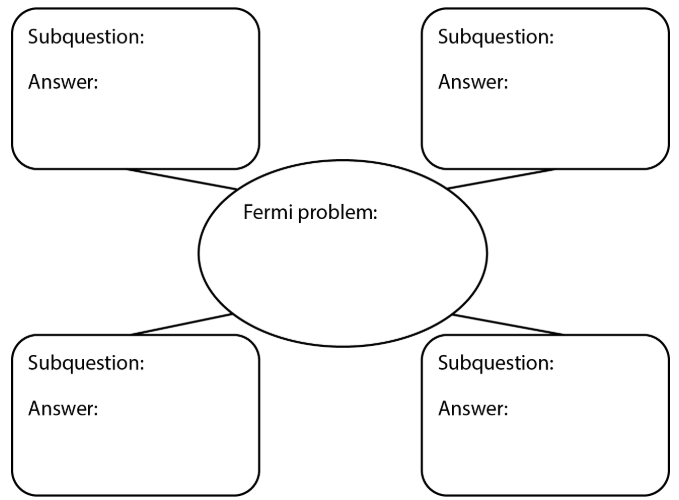14.1: A Fermi Problem
- Page ID
- 39919
\( \newcommand{\vecs}[1]{\overset { \scriptstyle \rightharpoonup} {\mathbf{#1}} } \) \( \newcommand{\vecd}[1]{\overset{-\!-\!\rightharpoonup}{\vphantom{a}\smash {#1}}} \)\(\newcommand{\id}{\mathrm{id}}\) \( \newcommand{\Span}{\mathrm{span}}\) \( \newcommand{\kernel}{\mathrm{null}\,}\) \( \newcommand{\range}{\mathrm{range}\,}\) \( \newcommand{\RealPart}{\mathrm{Re}}\) \( \newcommand{\ImaginaryPart}{\mathrm{Im}}\) \( \newcommand{\Argument}{\mathrm{Arg}}\) \( \newcommand{\norm}[1]{\| #1 \|}\) \( \newcommand{\inner}[2]{\langle #1, #2 \rangle}\) \( \newcommand{\Span}{\mathrm{span}}\) \(\newcommand{\id}{\mathrm{id}}\) \( \newcommand{\Span}{\mathrm{span}}\) \( \newcommand{\kernel}{\mathrm{null}\,}\) \( \newcommand{\range}{\mathrm{range}\,}\) \( \newcommand{\RealPart}{\mathrm{Re}}\) \( \newcommand{\ImaginaryPart}{\mathrm{Im}}\) \( \newcommand{\Argument}{\mathrm{Arg}}\) \( \newcommand{\norm}[1]{\| #1 \|}\) \( \newcommand{\inner}[2]{\langle #1, #2 \rangle}\) \( \newcommand{\Span}{\mathrm{span}}\)\(\newcommand{\AA}{\unicode[.8,0]{x212B}}\)
Lesson
Let's solve a Fermi problem.
Exercise \(\PageIndex{1}\): Fix It!
Andre likes a hot cocoa recipe with 1 cup of milk and 3 tablespoons of cocoa. He poured 1 cup of milk but accidentally added 5 tablespoons of cocoa.

- How can you fix Andre’s mistake and make his hot cocoa taste like the recipe?
- Explain how you know your adjustment will make Andre’s hot cocoa taste the same as the one in the recipe.
Exercise \(\PageIndex{2}\): Who Was Fermi?
- Record the Fermi question that your class will explore together.
- Make an estimate of the answer. If making an estimate is too hard, consider writing down a number that would definitely be too low and another number that would definitely be too high.
- What are some smaller sub-questions we would need to figure out to reasonably answer our bigger question?
- Think about how the smaller questions above should be organized to answer the big question. Label each smaller question with a number to show the order in which they should be answered. If you notice a gap in the set of sub-questions (i.e., there is an unlisted question that would need to be answered before the next one could be tackled), write another question to fill the gap.
Exercise \(\PageIndex{3}\): Researching Your Own Fermi Problem
- Brainstorm at least five Fermi problems that you want to research and solve. If you get stuck, consider starting with “How much would it cost to . . .?” or “How long would it take to . . .?”
- Pause here so your teacher can review your questions and approve one of them.
- Use the graphic organizer to break your problem down into sub-questions.

- Find the information you need to get closer to answering your question. Measure, make estimates, and perform any necessary calculations. If you get stuck, consider using tables or double number line diagrams.
- Create a visual display that includes your Fermi problem and your solution. Organize your thinking so it can be followed by others.


